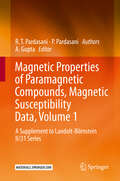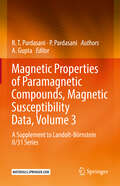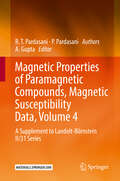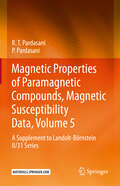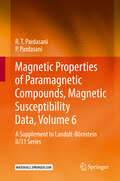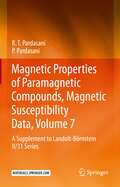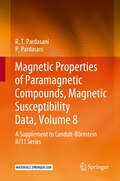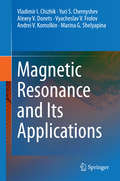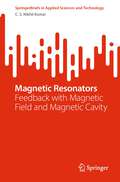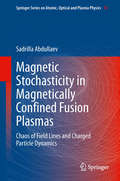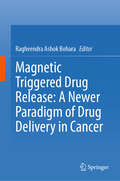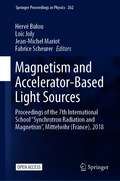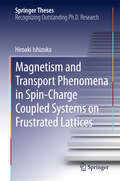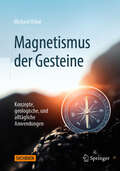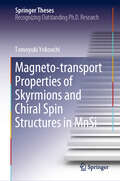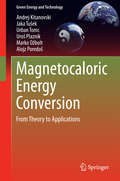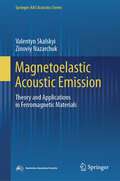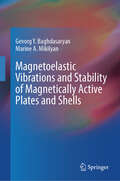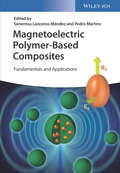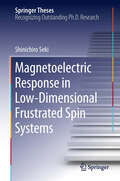- Table View
- List View
Magnetic Properties of Paramagnetic Compounds, Magnetic Susceptibility Data, Volume 1: A Supplement to Landolt-Börnstein II/31 Series
by P. Pardasani R.T. PardasaniWith the objective to collate the enormous amount of information on magnetic susceptibility parameters of a very large number of a variety of skeletons and present it in a form that can readily be retrieved and used, a new pattern is being introduced with the present volume keeping in view that now a majority of research groups look at the scientific data electronically. In this volume, magnetic properties of Y, La, Ti, Zr, V, Cr, Mo, W, Mn, Re, and Fe complexes are described. All the magnetic properties of each individual substance are listed as a single document which is self-explainable and allowing search in respect of substance name, synonyms, common vocabulary, and even structure.
Magnetic Properties of Paramagnetic Compounds, Magnetic Susceptibility Data, Volume 2: A Supplement to Landolt-Börnstein II/31 Series
by P. Pardasani R.T. PardasaniWith the objective to collate the enormous amount of information on magnetic susceptibility parameters of a very large number of a variety of skeletons and present it in a form that can readily be retrieved and used, a new pattern is being introduced with the present volume keeping in view that now a majority of research groups look at the scientific data electronically. This volume describes magnetic properties of complexes of Fe, Ru, Co, and Rh. All the magnetic properties of each individual substance are listed as a single document which is self-explainable and allowing search in respect of substance name, synonyms, common vocabulary, and even structure.
Magnetic Properties of Paramagnetic Compounds, Magnetic Susceptibility Data, Volume 3: A Supplement to Landolt-Börnstein II/31 Series
by P. Pardasani R.T. PardasaniWith the objective to collate the enormous amount of information on magnetic susceptibility parameters of a very large number of a variety of skeletons and present it in a form that can readily be retrieved and used, a new pattern is being introduced with the present volume keeping in view that now a majority of research groups look at the scientific data electronically. In this volume, magnetic properties of Ni, Pd, Pt, Ce, Pr, Nd, Sm, Eu, Gd, Tb, Dy, Ho, Er, Tm, Yb, Lu, Th, and U complexes are described. All the magnetic properties of each individual substance are listed as a single document which is self-explainable and allowing search in respect of substance name, synonyms, common vocabulary, and even structure.
Magnetic Properties of Paramagnetic Compounds, Magnetic Susceptibility Data, Volume 4: A Supplement to Landolt-Börnstein II/31 Series
by P. Pardasani R.T. PardasaniWith the objective to collate the enormous amount of information on magnetic susceptibility parameters of a very large number of a variety of skeletons and present it in a form that can readily be retrieved and used, a new pattern is being introduced with the present volume keeping in view that now a majority of research groups look at the scientific data electronically. In this volume, magnetic properties of complexes of Cu are described. All the magnetic properties of each individual substance are listed as a single document which is self-explainable and allowing search in respect of substance name, synonyms, common vocabulary, and even structure.
Magnetic Properties of Paramagnetic Compounds, Magnetic Susceptibility Data, Volume 5: A Supplement to Landolt-Börnstein II/31 Series
by P. Pardasani R.T. PardasaniWith the objective to collate the enormous amount of information on magnetic susceptibility parameters of a very large number of a variety of skeletons and present it in a form that can readily be retrieved and used, a new pattern is being introduced with the present volume keeping in view that now a majority of research groups look at the scientific data electronically.In this volume, magnetic properties of complexes of La, Ti, V, Cr, Mo, Mn, Re, Fe, Ru, Os, Co, Rh, Ni, Pd, Pt, Cu, Au, Ce, Pr, Nd, Sm, Gd, Tb, Ho, Yb are described.All the magnetic properties of each individual substance are listed as a single document which is self-explainable and allowing search in respect of substance name, synonyms, common vocabulary, and even structure.
Magnetic Properties of Paramagnetic Compounds, Magnetic Susceptibility Data, Volume 6: A Supplement to Landolt-Börnstein II/31 Series
by P. Pardasani R.T. PardasaniWith the objective to collate the enormous amount of information on magnetic susceptibility parameters of a very large number of a variety of skeletons and present it in a form that can readily be retrieved and used, a new pattern is being introduced with the present volume keeping in view that now a majority of research groups look at the scientific data electronically.In this volume, magnetic properties of complexes of La, Ti, Zr, V, Cr, W, Mn, Fe, Ru, Os, Co, Ni, Pd, Pt, Cu, Ag, Ce, Pr, Nd, Sm, Ho are described.All the magnetic properties of each individual substance are listed as a single document which is self-explainable and allowing search in respect of substance name, synonyms, common vocabulary, and even structure.
Magnetic Properties of Paramagnetic Compounds, Magnetic Susceptibility Data, Volume 7: A Supplement to Landolt-Börnstein II/31 Series
by P. Pardasani R.T. PardasaniWith the objective to collate the enormous amount of information on magnetic susceptibility parameters of a very large number of a variety of skeletons and present it in a form that can readily be retrieved and used, a new pattern is being introduced with the present volume keeping in view that now a majority of research groups look at the scientific data electronically.In this volume, magnetic properties of complexes of ???(La, Ti, V, Cr, Mo, Mn, Re, Fe, Ru, Os, Co, Rh, Ni, Pd, Pt, Cu, Au, Ce, Pr, Nd, Sm, Gd, Tb, Ho, Yb)??? are described.All the magnetic properties of each individual substance are listed as a single document which is self-explainable and allowing search in respect of substance name, synonyms, common vocabulary, and even structure.
Magnetic Properties of Paramagnetic Compounds, Magnetic Susceptibility Data, Volume 8: A Supplement to Landolt-Börnstein II/31 Series
by P. Pardasani R.T. PardasaniWith the objective to collate the enormous amount of information on magnetic susceptibility parameters of a very large number of a variety of skeletons and present it in a form that can readily be retrieved and used, a new pattern is being introduced with the present volume keeping in view that now a majority of research groups look at the scientific data electronically.In this volume, magnetic properties of complexes of ???(La, Ti, V, Cr, Mo, Mn, Re, Fe, Ru, Os, Co, Rh, Ni, Pd, Pt, Cu, Au, Ce, Pr, Nd, Sm, Gd, Tb, Ho, Yb)??? are described.All the magnetic properties of each individual substance are listed as a single document which is self-explainable and allowing search in respect of substance name, synonyms, common vocabulary, and even structure.
Magnetic Resonance and Its Applications
by Vladimir I. Chizhik Yuri S. Chernyshev Alexey V. Donets Vyacheslav V. Frolov Andrei V. Komolkin Marina G. ShelyapinaThe book is devoted to the description of the fundamentals in the area of magnetic resonance. The book covers two domains: radiospectroscopy and quantum radioelectronics. Radiospectroscopy comprises nuclear magnetic resonance , electron paramagnetic resonance, nuclear quadrupolar resonance, and some other phenomena. The radiospectroscopic methods are widely used for obtaining the information on internal (nano, micro and macro) structure of objects. Quantum radioelectronics, which was developed on the basis of radiospectroscopic methods, deals with processes in quantum amplifiers, generators and magnetometers. We do not know analogues of the book presented. The book implies a few levels of the general consideration of phenomena, that can be useful for different groups of readers (students, PhD students, scientists from other scientific branches: physics, chemistry, physical chemistry, biochemistry, biology and medicine).
Magnetic Resonance of Semiconductors and Their Nanostructures: Basic and Advanced Applications (Springer Series in Materials Science #253)
by Pavel G. Baranov Hans Jürgen Bardeleben Fedor Jelezko Jörg WrachtrupDifferent magnetic resonance (MR) methods and their applications in solids (e. g. semiconductors and nanostructures) are the focus of this work. Techniques and combinations thereof are explained and used to analyze defects in semiconductors and nanostructures. Presented for the first time are novelties such as single defects MR as well as state-of-art high-frequency pulse methods: EPR, ODMR, ENDOR. An overview of MR methods currently used to study defects, such as electron paramagnetic resonance (EPR), optically detected magnetic resonance (ODMR), electron-nuclear double resonance (ENDOR) etc. is provided. Problems existing in semiconductor and nanotechnology sciences which are resolved by MR are given. The past and current state and perspectives of application of MR are provided with emphasis on advances in MR methods. Intended for researchers in MR studies of semiconductors and nanostructures wanting a comprehensive review of what has been done in their and related fields of studies as well as future perspectives.
Magnetic Resonators: Feedback with Magnetic Field and Magnetic Cavity (SpringerBriefs in Applied Sciences and Technology)
by C. S. Nikhil KumarThe phase-locking of multiple spin-torque nano oscillators(STNOs) is considered the primary vehicle to achieve sufficient signal quality for applications. This book highlights the resonator's design and its need for feedback for phase locking of STNOs. STNOs can act as sources of tunable microwaves after being phase-locked together. External feedback from a coplanar waveguide placed above an STNO helps ensures coherent single domain oscillations. STNOs placed within magnonic crystal cavities also demonstrate coherent oscillations. Arrays of such cavities provide a route to scale power levels from such nano-oscillators. The book presents numerical and micromagnetics to validate the design.
Magnetic Stochasticity in Magnetically Confined Fusion Plasmas
by Sadrilla AbdullaevThis is the first book to systematically consider the modern aspects of chaotic dynamics of magnetic field lines and charged particles in magnetically confined fusion plasmas. The analytical models describing the generic features of equilibrium magnetic fields and magnetic perturbations in modern fusion devices are presented. It describes mathematical and physical aspects of onset of chaos, generic properties of the structure of stochastic magnetic fields, transport of charged particles in tokamaks induced by magnetic perturbations, new aspects of particle turbulent transport, etc. The presentation is based on the classical and new unique mathematical tools of Hamiltonian dynamics, like the action--angle formalism, classical perturbation theory, canonical transformations of variables, symplectic mappings, the Poincaré-Melnikov integrals. They are extensively used for analytical studies as well as for numerical simulations of magnetic field lines, particle dynamics, their spatial structures and statistical properties. The numerous references to articles on the latest development in the area are provided. The book is intended for graduate students and researchers who interested in the modern problems of magnetic stochasticity in magnetically confined fusion plasmas. It is also useful for physicists and mathematicians interested in new methods of Hamiltonian dynamics and their applications.
Magnetic Triggered Drug Release: A Newer Paradigm of Drug Delivery in Cancer
by Raghvendra Ashok BoharaThis book discusses the potential of magnetic nanoparticles in cancer therapy. It reviews the synthesis of magnetic nanoparticles – which, due to their small size and processability, have become widely used in various biomedical applications – and their role in cancer diagnosis, drug delivery, and personalized medicine. It presents the applications of magnetic nanoparticle in the destruction of tumor cells by heating them to their apoptosis threshold. It also introduces the new perspective in the development of magnetic field induced drug release in the cancer treatment. Importantly, the book covers the innovative three arm approach in cancer treatment by magnetic nanoparticles through inducing apoptosis, activating the immune response, and targeted-drug delivery. It highlights various novel approaches to improve the biocompatibility, half-life, and biodegradability of magnetic nanoparticles. In closing, the book offers comprehensive descriptions of numerous challenges involved in applying magnetic nanoparticles to cancer treatment.
Magnetism and Accelerator-Based Light Sources: Proceedings of the 7th International School ‘‘Synchrotron Radiation and Magnetism’’, Mittelwihr (France), 2018 (Springer Proceedings in Physics #262)
by Hervé Bulou Loïc Joly Jean-Michel Mariot Fabrice ScheurerThis open access book collects the contributions of the seventh school on Magnetism and Synchrotron Radiation held in Mittelwihr, France, from 7 to 12 October 2018. It starts with an introduction to the physics of modern X-ray sources followed by a general overview of magnetism. Next, light / matter interaction in the X-ray range is covered with emphasis on different types of angular dependence of X-ray absorption spectroscopy and scattering. In the end, two domains where synchrotron radiation-based techniques led to new insights in condensed matter physics, namely spintronics and superconductivity, are discussed. The book is intended for advanced students and researchers to get acquaintance with the basic knowledge of X-ray light sources and to step into synchrotron-based techniques for magnetic studies in condensed matter physics or chemistry.
Magnetism and Magnetic Materials
by J. M. D. CoeyCovering basic physical concepts, experimental methods, and applications, this book is an indispensable text on the fascinating science of magnetism, and an invaluable source of practical reference data. Accessible, authoritative, and assuming undergraduate familiarity with vectors, electromagnetism and quantum mechanics, this textbook is well suited to graduate courses. Emphasis is placed on practical calculations and numerical magnitudes - from nanoscale to astronomical scale - focussing on modern applications, including permanent magnet structures and spin electronic devices. Each self-contained chapter begins with a summary, and ends with exercises and further reading. The book is thoroughly illustrated with over 600 figures to help convey concepts and clearly explain ideas. Easily digestible tables and data sheets provide a wealth of useful information on magnetic properties. The 38 principal magnetic materials, and many more related compounds, are treated in detail.
Magnetism and Transport Phenomena in Spin-Charge Coupled Systems on Frustrated Lattices
by Hiroaki IshizukaIn this thesis, magnetism and transport phenomena in spin-charge coupled systems on frustrated lattices are theoretically investigated, focusing on Ising-spin Kondo lattice models and using a combination of Monte Carlo simulation and other techniques such as variational calculations and perturbation theory. The emphasis of the study is on how the cooperation of spin-charge coupling and geometrical frustration affects the thermodynamic properties of the Kondo lattice models; it presents the emergence of various novel magnetic states, such as the partial disorder, loop-liquid, and spin-cluster states. The thesis also reveals that the magnetic and electronic states and transport properties of these models demonstrate peculiar features, such as Dirac half-metals, anomalous Hall insulators, and spin Hall effects. Study of novel magnetic states and exotic transport phenomena in Kondo lattice systems is a field experiencing rapid progress. The interplay of charge and spin degrees of freedom potentially gives rise to various novel phases and transport phenomena which are related to strongly correlated electrons, frustrated magnetism, and topological states of matter. The results presented in this thesis include numerical calculations that are free from approximations. Accordingly, they provide reliable reference values, both for studying magnetism and transports of related models and for experimentally exploring novel states of matter in metallic magnets.
Magnetism of Rocks: Concepts, Geological, and Everyday Applications
by Michael UrbatHave you ever wondered how to explain to your friends and acquaintances what you specialize in within your scientific field? And have you tried to convey why this niche topic is incredibly exciting and directly related to everyday life? This book addresses exactly that: it invites you to take a closer look at our environment without getting lost in technical details, but rather to understand the underlying principles. It brings you closer to the world of paleomagnetism and rock magnetism, regardless of whether your concept of geology revolves around moving tectonic plates, dinosaurs, or rocks. The book takes you on an entertaining journey from the global phenomena of the Earth's magnetic field down to the subatomic level of electron movements in minerals. It provides selected geological scenarios for dynamic geological processes in our Earth system, from the formation of rocks in tranquil lakes to mountain building. No mathematical formulas are required for understanding, although terms like paramagnetism, ferromagnetism, coordinate transformations, and anisotropy will be explained. The book employs vivid analogies from everyday life to make complex concepts understandable. It's a successful introduction to the fascinating world of paleomagnetism and rock magnetism in geology for interested laypeople, amateur geologists, geoscientists, and related disciplines.
Magnetismus der Gesteine: Konzepte, geologische, und alltägliche Anwendungen
by Michael UrbatHaben Sie sich jemals gefragt, wie Sie Ihren Freunden und Bekannten erklären können, worauf Sie sich in Ihrem naturwissenschaftlichen Fachgebiet spezialisiert haben? Und haben Sie versucht zu vermitteln, warum dieses Nischenthema unglaublich spannend ist und einen direkten Bezug zum täglichen Leben hat? Genau hier setzt dieses Buch an: Es lädt Sie ein, einen genaueren Blick auf unsere Umwelt zu werfen, ohne sich in technischen Details zu verlieren, sondern eher, um das zugrunde liegende Prinzip zu verstehen. Es bringt Ihnen die Welt der Paläo- und Gesteinsmagnetik näher, ganz gleich, ob sich Ihre Vorstellung von Geologie zwischen bewegenden Erdplatten, Dinosauriern und Steinen bewegt. Das Buch begleitet Sie auf einer unterhaltsamen Reise von den globalen Phänomenen des Erdmagnetfeldes bis hinunter auf die subatomare Ebene der Elektronenbewegungen in Mineralen. Es liefert Ihnen ausgewählte geologische Szenarien für dynamische geologische Prozesse unseres Erdsystems von der Entstehung von Gesteinen in ruhigen Seen bis hin zur Gebirgsbildung. Für das Verständnis sind keinerlei mathematische Formeln erforderlich, obwohl Begriffe wie Paramagnetismus, Ferromagnetismus, Koordinatentransformationen und Anisotropie erklärt werden müssen. Das Buch bedient sich anschaulicher Analogien aus dem Alltag, um komplexe Sachverhalte verständlich zu machen. Ein gelungener Einstieg in die faszinierende Welt der Paläo- und Gesteinsmagnetik in der Geologie für interessierte Laien, Hobby-Geolog*innen, Geowissenschaftler*innen und angrenzende Disziplinen.
Magneto-transport Properties of Skyrmions and Chiral Spin Structures in MnSi (Springer Theses)
by Tomoyuki YokouchiThis book provides extensive and novel insights into transport phenomena in MnSi, paving the way for applying the topology and chirality of spin textures to the development of spintronics devices. In particular, it describes in detail the key measurements, e.g. magnetoresistance and nonlinear electronic transport, and multiple material-fabrication techniques based on molecular beam epitaxy, ion-beam microfabrication and micromagnetic simulation. The book also reviews key aspects of B20-type MnSi chiral magnets, which host magnetic skyrmions, nanoscale objects formed by helical spatial spin structures. Readers are then introduced to cutting-edge findings on the material. Furthermore, by reviewing the author’s successful experiments, the book provides readers with a valuable update on the latest achievements in the measurement and fabrication of magnetic materials in spintronics.
Magnetocaloric Energy Conversion
by Andrej Kitanovski Jaka Tušek Urban Tomc Uroš Plaznik Marko Ožbolt Alojz PoredošThis book provides the latest research on a new alternative form of technology, the magnetocaloric energy conversion. This area of research concerns magnetic refrigeration and cooling, magnetic heat pumping and magnetic power generation. The book's systematic approach offers the theoretical basis of magnetocaloric energy conversion and its various sub domains and this is supported with the practical examples. Besides these fundamentals, the book also introduces potential solutions to engineering problems in magnetocalorics and to alternative technologies of solid state energy conversion. The aim of the book is therefore to provide engineers with the most up-to-date information and also to facilitate the understanding, design and construction of future magnetocaloric energy conversion devices. The magnetocaloric energy conversion represents an alternative to compressor based refrigerators and heat pumps. It is a serious alternative to power generation with low enthalpy heat sources. This green technology offers an opportunity to use environmentally friendly solid refrigerants and the potentially high energy efficiency follows the trends of future energy conversion devices. This book is intended for postgraduate students and researchers of refrigeration, heat pumping, power generation alternatives, heat regenerators and advanced heat transfer mechanisms.
Magnetoconvection
by N. O. Weiss M. R. E. ProctorThe last thirty years have seen great leaps forward in the subject of magnetoconvection. Computational techniques can now explain exotic nonlinear behaviour, transition to chaos and the formation of structures that can be observed on the surface of the Sun. Here, two leading experts present the current state of knowledge of the subject. They provide a mathematical and numerical treatment of the interactions between electrically conducting fluids and magnetic fields that lead to the complex structures and rich behaviour observed on the Sun and other stars, as well as in the interiors of planets like the Earth. The authors' combined analytical and computational approach provides a model for the study of a wide range of related problems. The discussion includes bifurcation theory, chaotic behaviour, pattern formation in two and three dimensions, and applications to geomagnetism and to the properties of sunspots and other features at the solar surface.
Magnetoelastic Acoustic Emission: Theory and Applications in Ferromagnetic Materials (Springer-AAS Acoustics Series)
by Zinoviy Nazarchuk Valentyn SkalskyiThe book presents theoretical and experimental studies to establish the relationship between volume jumps of the 90° domain wall in a ferromagnetic material and the magnitude of the half-space surface displacement caused by it. A method of evaluating the influence of the external magnetic field on the stress intensity factor at the tip of the crack-like defects in ferromagnets is discussed. The influence of hydrogen on the generation of magneto-elastic acoustic emission signals of ferromagnets is described. The features of magneto-elastic acoustic emission due to the presence of plastic deformation, structural changes, and volumetric damage in such structural materials are shown.
Magnetoelastic Vibrations and Stability of Magnetically Active Plates and Shells
by Gevorg Y. Baghdasaryan Marine A. MikilyanThis book introduces the reader to methods of mathematical modeling and solving non-stationary (dynamic) problems of the theory of magnetoelasticity, as well as to give an idea of the wealth of physical effects caused by the interaction of electromagnetic and mechanical phenomena in magnetically active elastic thin bodies. The studies are mainly limited to a model of isotropic body under the assumption of small deformations. In the first chapter of the book, based on the basic connected nonlinear equations and relations of mechanics and quasi-static electrodynamics of continuum media, a system of equations of magnetoelasticity, surface conditions, and governing equations describing the behavior of disturbances in a magnetoactive medium interacting with an external magnetic field is obtained. On this basis, in Chapters 2 and 3, using the main equations and relations of magnetoelastic vibrations and stability of magnetically soft, thin plates and shells are obtained. By solving specific applied problems, a number of qualitative and quantitative results were identified, caused by the interaction of mechanical and magnetic phenomena in ferromagnetic thin bodies. An approximate formula is obtained to determine magnetohydrodynamic pressure on the oscillating surfaces of plate flowing by supersonic flow of perfectly conducting gas in the presence of magnetic field. This formula is the generalization of well-known formula obtained on the basis of the classical piston theory of gas dynamics in the case of magneto-gas-dynamic flow. On this basis, it became possible to solve complex problems of aeromagnetoelasticity. In the 4th and 5th chapters magnetoelastic processes in superconducting thin shells located in stationary and non-stationary magnetic fields are studied. Two-dimensional equations and corresponding conditions are obtained, which characterize vibrations and stability of superconducting cylindrical and spherical shells under the influence of the given magnetic field. By solving specific problems, the possibility of loss of both static and dynamic stability of thin superconducting bodies under the influence of external magnetic field has been established. The sixth chapter is devoted to mathematical modeling and investigation of issues of dynamics of magnetostrictive plates in magnetic fields (stationary and non-stationary) of several orientations. To study the processes of magnetoelastic interaction in the plate under consideration with complex physical properties of its material, the main postulates of the classical theories and methods were used. The influence of plate in-homogeneity on the processes under consideration was also studied. Dynamic processes in layered plates have been studied. It is shown that heterogeneity is sufficient to control optimally the studied dynamic processes, especially those that arise as a result of interaction. The last 7th chapter is devoted to the investigation of stability of dielectric thin plates in a supersonic flow of perfectly conducting gas in the presence of magnetic field. The problems were studied in both linear and nonlinear formulations. Based on the formula obtained by the authors specific problems of stability were solved. Influence of magnetic field on the flutter characteristics is studied.
Magnetoelectric Polymer-Based Composites: Fundamentals and Applications
by Pedro Martins Senentxu Lanceros-MéndezThe first book on this topic provides a comprehensive and well-structured overview of the fundamentals, synthesis and emerging applications of magnetoelectric polymer materials. Following an introduction to the basic aspects of polymer based magnetoelectric materials and recent developments, subsequent chapters discuss the various types as well as their synthesis and characterization. There then follows a review of the latest applications, such as memories, sensors and actuators. The book concludes with a look at future technological advances. An essential reference for entrants to the field as well as for experienced researchers.
Magnetoelectric Response in Low-Dimensional Frustrated Spin Systems
by Shinichiro SekiElectric control of magnetic properties, or inversely, magnetic control of dielectric properties in solids, is called a magnetoelectric effect and has long been investigated from the point of view of both fundamental physics and potential application. Magnetic and dielectric properties usually show minimal coupling, but it recently has been discovered that magnetically induced ferroelectricity in some spiral magnets enables remarkably large and versatile magnetoelectric responses. To stabilize such helimagnetism, magnetic frustration (competition between different magnetic interactions) is considered the key. In the present work, two of the most typical frustrated spin systems--triangular lattice antiferromagnets and edge-shared chain magnets--have systematically been investigated. Despite the crystallographic simplicity of target systems, rich magnetoelectric responses are ubiquitously observed. The current results published here offer a useful guideline in the search for new materials with unique magnetoelectric functions, and also provide an important basis for a deeper understanding of magnetoelectric phenomena in more complex systems.
